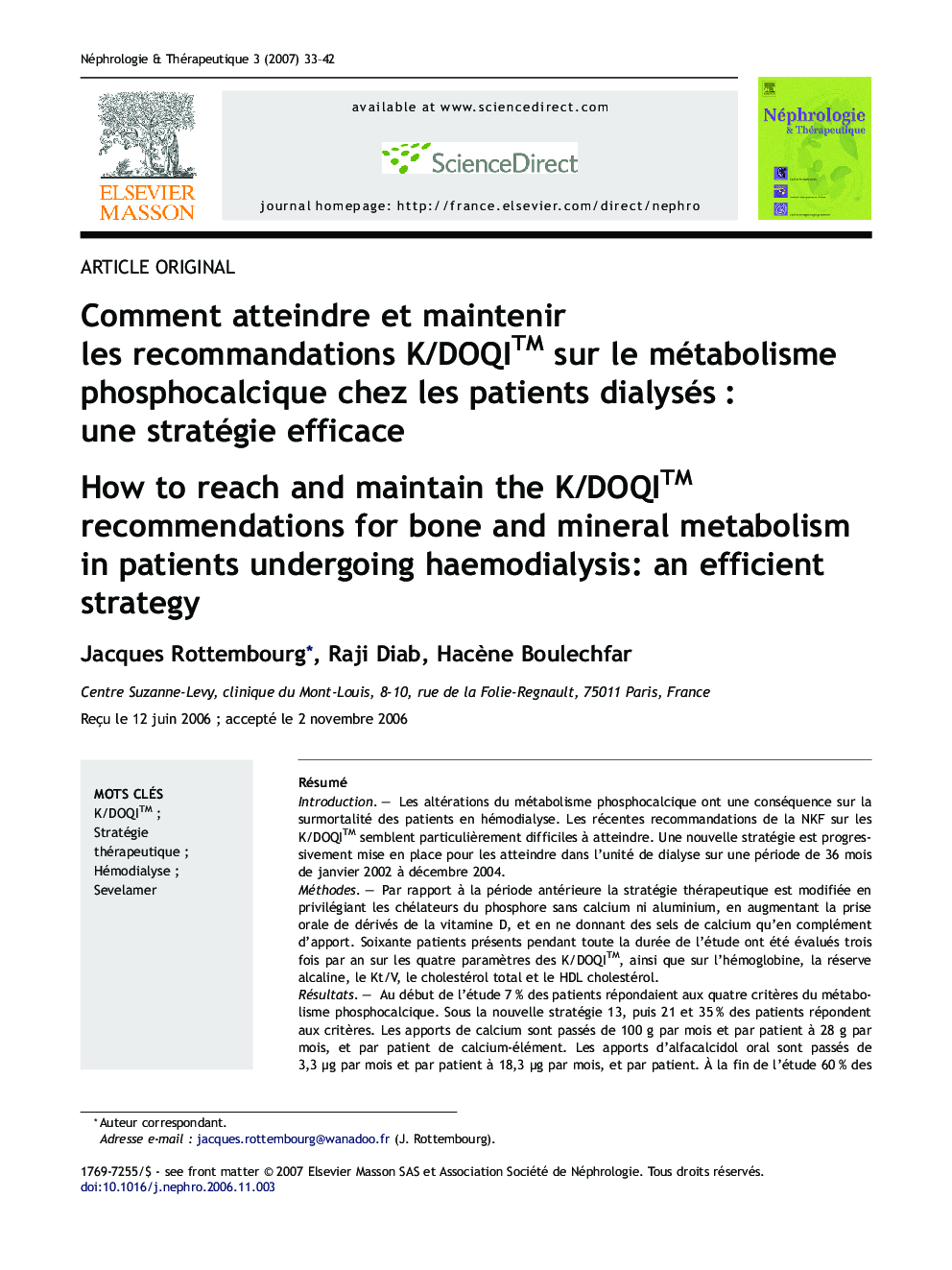| کد مقاله | کد نشریه | سال انتشار | مقاله انگلیسی | نسخه تمام متن |
|---|---|---|---|---|
| 3895604 | 1250173 | 2007 | 10 صفحه PDF | دانلود رایگان |

RésuméIntroductionLes altérations du métabolisme phosphocalcique ont une conséquence sur la surmortalité des patients en hémodialyse. Les récentes recommandations de la NKF sur les K/DOQITM semblent particulièrement difficiles à atteindre. Une nouvelle stratégie est progressivement mise en place pour les atteindre dans l'unité de dialyse sur une période de 36 mois de janvier 2002 à décembre 2004.MéthodesPar rapport à la période antérieure la stratégie thérapeutique est modifiée en privilégiant les chélateurs du phosphore sans calcium ni aluminium, en augmentant la prise orale de dérivés de la vitamine D, et en ne donnant des sels de calcium qu'en complément d'apport. Soixante patients présents pendant toute la durée de l'étude ont été évalués trois fois par an sur les quatre paramètres des K/DOQITM, ainsi que sur l'hémoglobine, la réserve alcaline, le Kt/V, le cholestérol total et le HDL cholestérol.RésultatsAu début de l'étude 7 % des patients répondaient aux quatre critères du métabolisme phosphocalcique. Sous la nouvelle stratégie 13, puis 21 et 35 % des patients répondent aux critères. Les apports de calcium sont passés de 100 g par mois et par patient à 28 g par mois, et par patient de calcium-élément. Les apports d'alfacalcidol oral sont passés de 3,3 μg par mois et par patient à 18,3 μg par mois, et par patient. À la fin de l'étude 60 % des patients étaient sous sevelamer à la dose moyenne de 4800 mg/jour. Le taux d'hémoglobine est stable, la réserve alcaline s'abaisse en raison d'apports de carbonate de calcium moindres. Sous statines le rapport cholestérol total/HDL cholestérol s'abaisse à 3,3.ConclusionUne modification de la stratégie thérapeutique permet à un plus grand nombre de patients de répondre aux recommandations des K/DOQITM avec l'espoir d'une moindre mortalité et morbidité cardiovasculaire.
IntroductionRecent publications have indicated that alterations in bone and mineral metabolism are known to participate to a high mortality rate in patients undergoing haemodialysis. A new therapeutic strategy is progressively undertaken in the dialysis unit over a 36 months period covering years 2002 to 2004.MethodsThis new strategy includes the prescription of non-calcium, non-aluminium phosphate binder, sevelamer hydrochloride, an increase in vitamin D analogues prescription and a moderation in calcium carbonate administration. Sixty patients participated to the entire study and are evaluated three times a year on the four K/DOQITM parameters. Other indicators such as haemoglobin, bicarbonate, total cholesterol and HDL cholesterol levels were studied.ResultsAt the beginning of the study, 7% of the patients achieved the four K/DOQITM parameters. This proportion seemed identical to those observed in the major studies. But progressively with the new therapeutic strategy 13%, then 21%, and at the end of the study 35% reached the four criteria. Therapeutic calcium intakes decreased from 100 g per patient/month to 28 g per patient-month. Prescription of vitamin D analogues increased from 3,3 μg per patient-month to 18,3 μg per patient/month. At the end of the study 60% of the patients received sevelamer hydrochloride at the mean dosage of 4800 mg per day. Haemoglobin remains stable. Bicarbonate level decreased due to a minor prescription in calcium carbonate. Under statins the ratio total cholesterol/HDL cholesterol decreased to 3,3.ConclusionA modification in the therapeutic strategy offer to patients undergoing haemodialysis, the possibility to achieve the K/DOQITM recommendations with the hope to obtain a beneficial effect on patient outcomes.
Journal: Néphrologie & Thérapeutique - Volume 3, Issue 1, March 2007, Pages 33–42